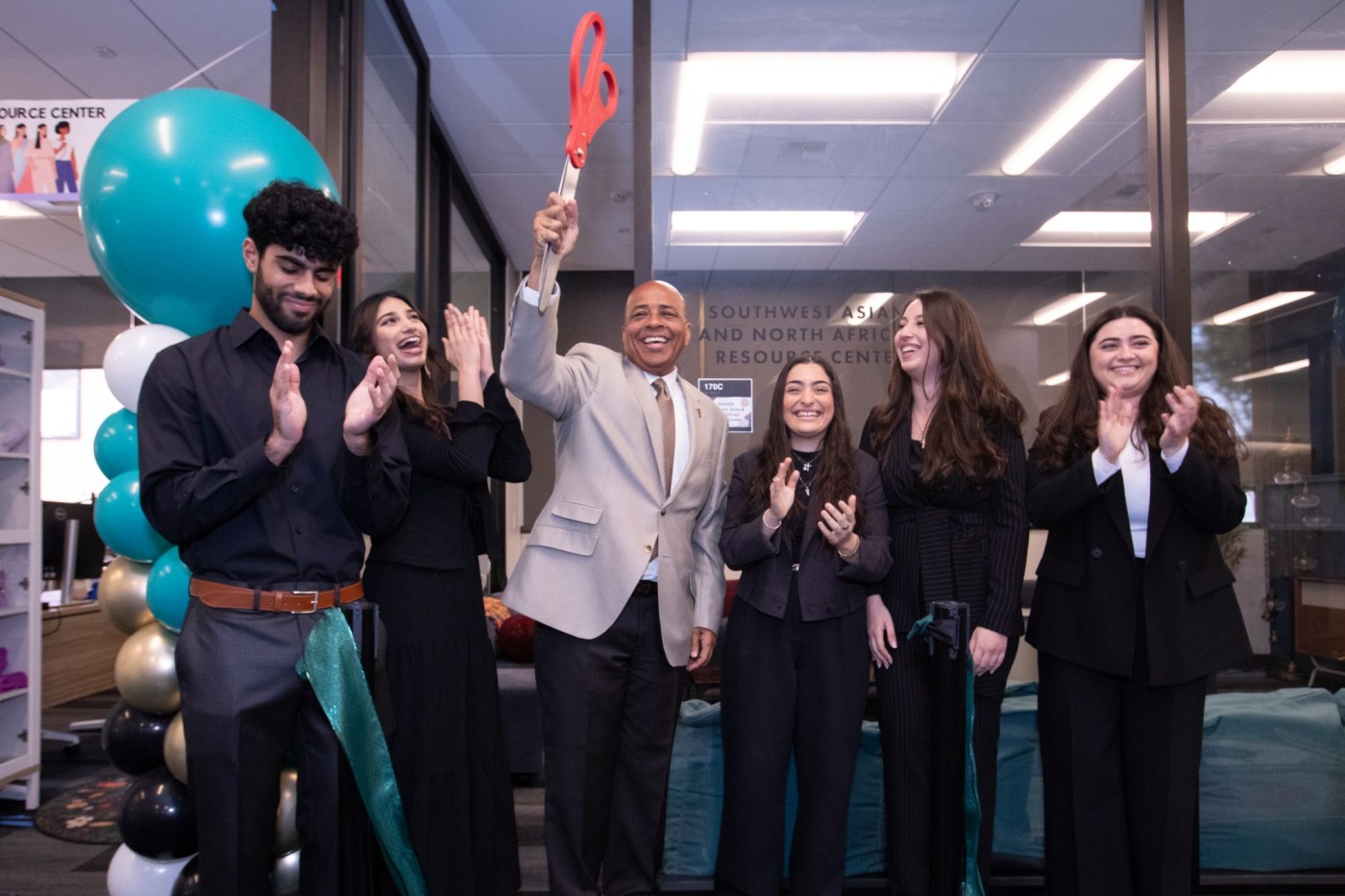The new SWANA Resource Center officially opened on Monday, April 21, in Cal State Fullerton’s Pollak Library, with a celebration that featured food, speakers and musical performances.
The acronym SWANA stands for Southwest Asian and North African, and students come from countries such as Lebanon, Afghanistan, Armenia, Iran, Syria, among others in the area often called the Middle East, a term originated by the British.
CSUF President Ronald Rochan made opening remarks and stood before a ceremonial ribbon while surrounded by smiling faces of students and staff who attended the event. Speakers also included Phenicia McCullough, vice president of human resources and inclusive excellence and student leader Talia Boukhalil, among others.
The SWANA Resource Center is a place where students whose family heritage and traditions are rooted in SWANA countries can find support and a shared sense of community.
On the Cal State Fullerton campus, resource centers provide a welcoming place for students to study, socialize, get academic support or just have some quiet time.
“I feel so privileged to have a SWANA Resource Center on our campus that represents my community,” said Boukhalil, who was born in Lebanon and graduates this year. “The generation before us recognized the need for this space and advocated for it at a time when they knew they may never experience it themselves. For so long, we’ve been erased, from checking ‘white’ on forms that don’t see us and living between the lines of systems that were never built for us. But this center changes that. It’s more than a space, it’s a statement that we exist, we matter, and we have a home here. It’s a quiet but powerful reminder that we belong here too.”
Studies show that spaces like resource centers can go a long way in motivating students to stay in college.
“Cal State Fullerton is committing very intentionally and consistently in resourcing SWANA communities and ensuring that students retain in higher numbers, that they matriculate and they’re able to graduate and meet our student success goals and outcomes because they feel a sense of belonging on campus,”said Saby Labor, interim associate director of the diversity initiatives and resource centers. “Resource centers are shown to positively impact student retention rates,” she said.
This is especially true for students attending college for the first time — they’re the ones most at risk of dropping out in their first year, Labor explained. “We try to be intentional about having them be part of smaller communities as possible in that first year,” she said.
A SWANA club was started by students several years ago, and last fall a minor in SWANA studies was approved after students presented a detailed proposal for it. The SWANA Resource Center is lnear the Native American and Indigenous Resource Center and the Women’s Resource Center, among others that have spaces on the first floor of the library.
Resource Centers also play a role in enriching the knowledge in the campus community of cultural traditions from around the world. For instance, a few weeks ago, SWANA students put on a cooking demonstration about the popular grain dish tabouleh, showing the many variations of tabouleh that are prepared in the various SWANA countries.
Feeling recognized and validated for who they are can help students face difficulties of being in college. “It will be one of the reasons that they choose to stay when there’s so many hardships and challenges that students encounter that might give them reasons to leave, even temporarily, their academic journey,” Labor said.
In the resource centers, Labor can maintain contact with students in a nonpressured environment and track anyone who is struggling and provide support. “We try to provide them more reasons to come back. We have really amazing staff and faculty who work here at the university, and we’re always checking in on students, asking them how they are doing. We’re genuinely interested in the answer to that.”
Boukhalil concurs that this kind of recognition and attention is critical for students. “Having a resource center specifically for the SWANA community makes us feel seen, heard and supported in a way that many of us have never experienced before,” she said. “It validates our identities and creates a space where our cultures, histories and stories are valued. The SWANA Center is more than just a room, it’s a living symbol of resilience, hope and belonging. I am forever grateful to the students who stood up, spoke out, and fought for our community to be seen. They have changed the lives of so many SWANA students without even knowing it.”
The grand opening of the new SWANA Resource Center, with positive messages from speakers, lively music performances and sweet desserts, was a welcoming event that demonstrated just a few of the cultural traditions that SWANA students bring to Cal State Fullerton.
